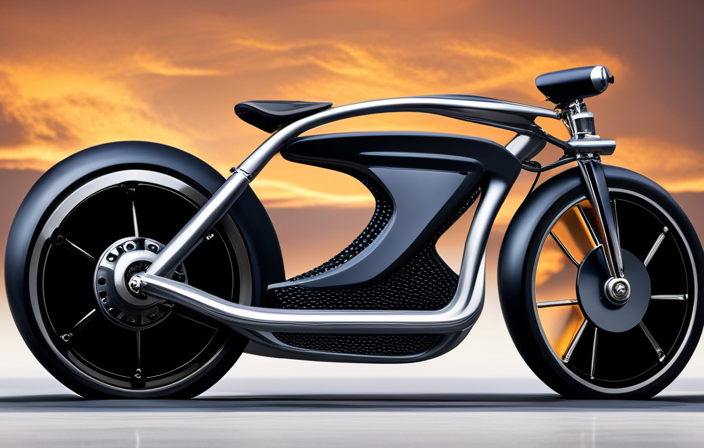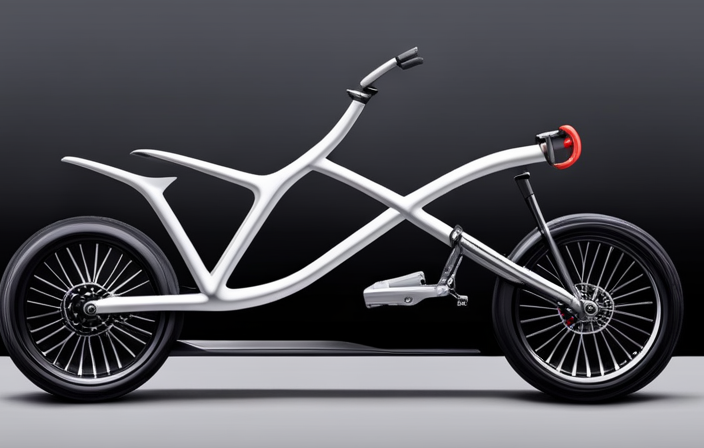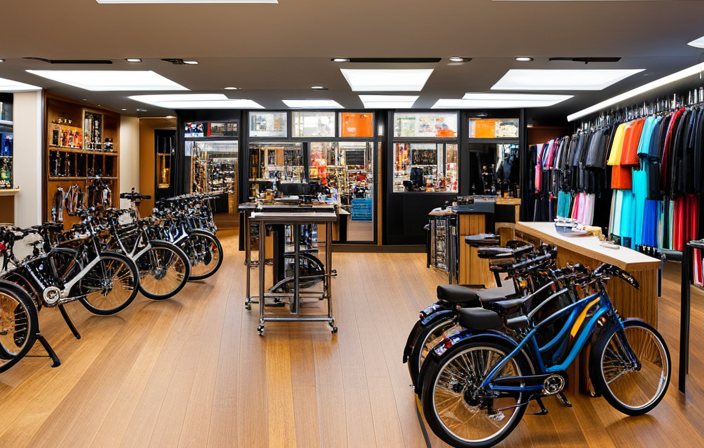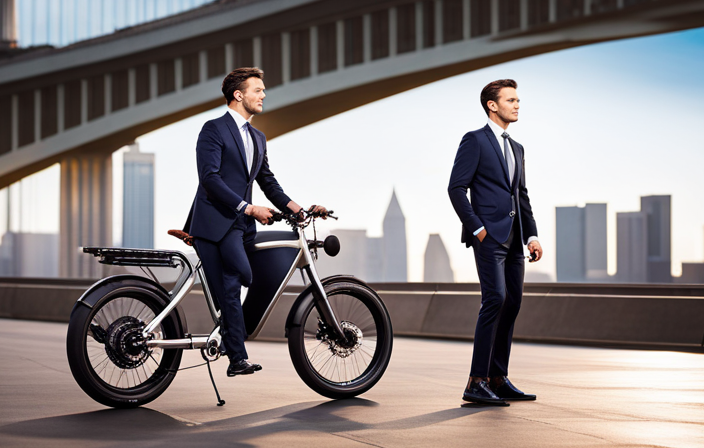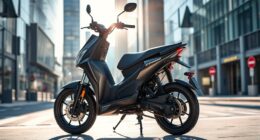As an avid electric bike enthusiast, I’ve always been fascinated by the intricate relationship between amps and power. It’s like unlocking the hidden potential of these two-wheeled wonders.
In this article, we’ll delve into the technical aspects of how amps translate to power on an electric bike. From understanding the basics of electric bike performance to exploring the impact of amps on speed, range, motor efficiency, accessories, maintenance, and customization, we’ll leave no stone unturned.
So buckle up, because we’re about to embark on an electrifying journey of knowledge.
Key Takeaways
- Amps directly affect the power, torque, speed, and range of an electric bike.
- Higher amps result in more power and better acceleration.
- Amps play a crucial role in climbing hills and overall bike performance.
- Understanding the amp requirements helps in customization and maintenance of electric bikes.
Understanding Amps and Power on an Electric Bike
To understand amps and power on your electric bike, you need to know how they translate into performance.
Amps, or ampere measurements, are a unit of electric current that determine how much power is flowing through the motor. In simple terms, the higher the amps, the more power your electric bike will have. But it’s not just about raw power.
Amps also have a direct relationship with torque. Torque is the rotational force that allows your bike to accelerate and climb hills. So, when you increase the amps, you are also increasing the torque output of your electric bike. This means that you will have better acceleration and climbing ability.
Understanding this relationship between amps and torque is crucial in optimizing the performance of your electric bike.
Now, let’s delve into the basics of electric bike performance.
The Basics of Electric Bike Performance
When it comes to understanding electric bike performance, it’s crucial to grasp the concepts of voltage, amps, and wattage.
Voltage refers to the amount of electrical potential difference, which determines the strength of the electric current.
Amps, on the other hand, measure the amount of electrical current flowing through the bike’s system.
Lastly, wattage indicates the rate at which electrical power is generated and used.
Voltage, Amps, and Wattage
Understanding the relationship between voltage, amps, and wattage is important when determining the power output of your electric bike. Here are three key points to help you understand power formulas and the impact of voltage on performance:
-
Voltage (V): Voltage refers to the electric potential difference between two points in a circuit. It determines the force that drives the electric current through the system. Higher voltage means more power available to the bike’s motor, resulting in increased speed and acceleration.
-
Amps (A): Amps, or amperes, measure the rate at which electric current flows through the circuit. The higher the amperage, the more current flows, delivering more power to the motor. It affects the torque and overall performance of the electric bike.
-
Wattage (W): Watts represent the actual power output of the electric bike. It is the product of voltage multiplied by amperage. Wattage determines the overall performance and capability of the bike.
Understanding the relationship between voltage, amps, and wattage allows you to make informed decisions when choosing components for your electric bike.
Now, let’s delve into how power is generated on an electric bike.
How Power is Generated on an Electric Bike
The generation of power on an electric bike relies on a combination of voltage, amperage, and wattage. When you pedal or use the throttle, the energy from your movement is converted into electrical energy. This energy conversion occurs within the motor controller, which controls the flow of electricity between the battery and the motor.
The battery provides the voltage, typically 36V or 48V, which determines the potential energy available. The amperage, measured in amps, represents the rate at which the electric current flows. The wattage, calculated by multiplying the voltage and amperage, quantifies the power output.
In essence, power generation on an electric bike involves converting the stored energy in the battery into electrical energy, which is then used to propel the bike forward. This process is crucial in understanding the relationship between amps and speed on an electric bike.
The Relationship Between Amps and Speed
Amps and speed are directly related on electric bikes. The amount of current drawn from the battery determines the power output of the motor, which in turn affects the bike’s speed. Higher amp draw results in more power and thus higher speeds. This relationship can be understood by examining the torque equation. Torque is directly proportional to the current flowing through the motor, meaning that more amps translate to greater torque. With increased torque, the motor can deliver more force to propel the bike forward, resulting in higher speeds. To illustrate this relationship, consider the following table:
| Amps Drawn | Torque Produced | Speed Achieved |
|---|---|---|
| 10 | Low | Slow |
| 15 | Medium | Moderate |
| 20 | High | Fast |
| 25 | Very High | Very Fast |
| 30 | Extremely High | Top Speed |
Understanding the correlation between amps and speed is crucial for selecting the appropriate electric bike for your needs. Now, let’s delve into the next section to explore how amps relate to the range of an electric bike.
Amps and Range: How Far Can You Go?
As we explored the relationship between amps and speed in the previous section, we now shift our focus to the crucial factor of range in electric bikes.
Maximizing range is vital for cyclists who rely on their bikes for long commutes or extended rides. To optimize battery life and achieve the furthest range possible, it is essential to consider the role of amps in this equation.
The amount of current flowing from the battery to the motor determines the power delivered to the wheels, and consequently, the distance the bike can cover on a single charge. By understanding the relationship between amps, battery capacity, and motor efficiency, we can make informed decisions to enhance our electric bike’s range.
Let’s delve into the topic of amps and motor efficiency to further unravel the complexities of electric bike performance.
Amps and Motor Efficiency
When it comes to electric bike motors, understanding the different types and their amp draw is crucial for optimizing efficiency.
There are various motor types available, such as hub motors or mid-drive motors, each with its own amp draw characteristics.
Additionally, it is important to consider how amps affect the overall efficiency of the motor, as higher amp draw can result in increased power consumption and potentially reduced range.
Motor Types and Amp Draw
One thing to consider is that different motor types have varying amp draw. The efficiency of a motor plays a crucial role in determining how much power it consumes.
The higher the motor efficiency, the lower the amp draw, which in turn can lead to a longer battery life. When selecting a motor for an electric bike, it is important to choose one that is efficient and has a low amp draw.
This will not only optimize the performance of the bike but also extend the battery life, allowing for longer rides without the need for frequent recharging.
Now, let’s explore how amps affect overall efficiency and the power output of an electric bike.
How Amps Affect Overall Efficiency
The efficiency of a motor is directly impacted by the amount of amps it draws. Amp draw refers to the amount of electrical current flowing through the motor. As the amp draw increases, so does the power consumption of the motor. This means that a motor with a higher amp draw will require more energy to operate and may result in decreased overall efficiency. To better understand the relationship between amp draw and power consumption, take a look at the table below:
| Amp Draw (A) | Power Consumption (W) |
|---|---|
| 5 | 500 |
| 10 | 1000 |
| 15 | 1500 |
| 20 | 2000 |
| 25 | 2500 |
As seen in the table, as the amp draw increases, the power consumption also increases proportionally. This information is crucial when designing and optimizing electric bike motors for maximum efficiency. Understanding the relationship between amp draw and power consumption allows manufacturers to develop motors that strike a balance between performance and energy efficiency. In the next section, we will explore the impact of amps on battery life.
The Impact of Amps on Battery Life
To maximize your electric bike’s battery life, you’ll want to consider the impact of amps. Amps play a crucial role in battery performance and optimizing battery usage.
The number of amps determines the rate at which energy is drawn from the battery. Higher amp draw can result in increased power output, but it also puts more strain on the battery, leading to faster depletion. On the other hand, lower amp draw can conserve battery life but may limit the bike’s performance.
Finding the right balance is essential. By understanding the impact of amps on battery life, you can make informed decisions about how to best utilize your electric bike’s power.
Now, let’s delve into the relationship between amps and performance upgrades.
Amps and Performance Upgrades
When upgrading, you’ll want to consider how increasing the number of amps in your battery can improve performance. Here are some key points to keep in mind:
- Higher amps allow for increased power output, resulting in faster acceleration and higher top speeds.
- Performance upgrades can include upgrading to a higher amp battery or adding a secondary battery to increase the overall amps.
- Upgrading to a higher amp battery can provide a significant boost in power, especially when combined with a compatible motor.
- Adding a secondary battery can provide additional amps and extend the overall range of your electric bike.
By considering these performance upgrades and understanding the different motor types, you can enhance the capabilities of your electric bike and enjoy a more exhilarating riding experience.
Now, let’s dive into amp monitoring and maintenance to ensure optimal performance without compromising your battery life.
Amp Monitoring and Maintenance
Monitoring and maintaining amps is essential for ensuring optimal performance and preserving battery life. Proper amp monitoring allows you to keep track of the power consumption and usage of your electric bike.
By regularly monitoring your amps, you can identify any abnormal fluctuations or patterns that may indicate a problem with your bike’s electrical system. This enables you to address issues promptly and prevent potential damage to your battery or motor.
Additionally, amp maintenance tips, such as keeping your battery charged within its recommended range and avoiding extreme temperatures, can help prolong the lifespan of your battery and ensure consistent power output.
By taking the time to monitor and maintain your amps, you can maximize the performance and longevity of your electric bike.
Transitioning into the subsequent section about ‘amps and riding style,’ it is important to note that understanding how amps translate to power is crucial for tailoring your riding style to optimize your electric bike’s performance.
Amps and Riding Style
When it comes to electric bikes, understanding amps and how they affect pedal assist modes is crucial. Amps determine the amount of power that is delivered to the motor, which directly impacts the level of assistance provided while pedaling.
Adjusting amps for different riding conditions is important in order to optimize performance and battery life. By delving into the relationship between amps and pedal assist modes, as well as learning how to fine-tune amps based on specific riding conditions, riders can enhance their overall electric bike experience.
Amps and Pedal Assist Modes
The pedal assist modes on electric bikes determine how many amps are sent to the motor. This is crucial for optimizing power output and enhancing pedal assist efficiency.
Here’s why you should pay attention to the pedal assist modes:
-
Increased Efficiency: By adjusting the pedal assist mode, you can fine-tune the amount of power you receive from the motor. This allows you to conserve energy while still enjoying a boost when needed.
-
Customized Riding Experience: Different pedal assist modes offer varying levels of assistance, allowing you to tailor your ride to your desired intensity. Whether you prefer a gentle push or a more powerful boost, the pedal assist modes give you control.
-
Extended Battery Life: By choosing the appropriate pedal assist mode, you can optimize power output and maximize your battery’s lifespan, ensuring longer rides without worrying about running out of juice.
Understanding the impact of pedal assist modes on amps is vital for achieving an optimal riding experience. Now, let’s explore how to adjust amps for different riding conditions without missing a beat.
Adjusting Amps for Different Riding Conditions
To optimize your riding experience for different conditions, you’ll want to make sure you adjust the amps accordingly. When it comes to uphill riding, increasing the amps can provide you with the extra power needed to conquer those challenging inclines. By adjusting the amps to a higher setting, the motor will deliver more current to the motor, resulting in increased torque and a smoother uphill ride. On the other hand, when it comes to long distance rides, optimizing the amps is crucial to maximize your battery life. By finding the right balance between power and efficiency, you can ensure that you have enough battery power to reach your destination without running out of juice. Referencing the table below can help you determine the ideal amp setting for different riding conditions.
| Riding Condition | Amp Setting |
|---|---|
| Uphill Riding | High |
| Long Distance Rides | Moderate |
| Flat Terrain | Low |
Now that we’ve covered adjusting amps for different riding conditions, let’s delve into the important topic of amps and safety considerations.
Amps and Safety Considerations
If you’re not careful with the amps on your electric bike, it could pose safety risks. Amps play a crucial role in determining the power output of your e-bike. Here are some important considerations regarding amps and safety:
-
Battery Capacity:
-
Higher amps can drain the battery faster, reducing the overall range of your e-bike.
-
Ensure that your battery has sufficient capacity to handle the amp requirements of your motor to avoid premature depletion.
-
Motor Power:
-
Higher amps can increase the motor power, allowing for faster acceleration and higher top speeds.
-
However, exceeding the recommended amp limit can put excessive strain on the motor, leading to overheating and potential damage.
-
Heat Dissipation:
-
Higher amps generate more heat, which can affect the performance and longevity of your e-bike components.
-
Proper heat dissipation measures like cooling fans or heat sinks can help mitigate safety risks associated with excessive heat buildup.
Considering these factors, it is crucial to understand the relationship between amps, battery capacity, and motor power to ensure a safe and enjoyable riding experience.
Transition: Now that we have discussed the safety considerations related to amps, let’s delve into the regulations governing amps on e-bikes without skipping a beat.
Amps and E-Bike Regulations
Now that you understand the safety considerations, it’s important to know how e-bike regulations affect the usage of amps. E-bike amp limits are set by various regulatory bodies to ensure the safe and efficient operation of electric bicycles. These amp limits are based on amp compliance standards that determine the maximum amount of current that an e-bike’s motor controller can draw from the battery. To give you a better understanding, here is a table showcasing the e-bike amp limits and compliance standards:
| Regulatory Body | E-Bike Amp Limit | Compliance Standard |
|---|---|---|
| EU | 15A | EN 15194 |
| US | 20A | Class 1 |
| Canada | 32A | CSA C22.2 |
| Australia | 25A | AS 5034 |
These regulations ensure that e-bikes operate within safe limits and prevent overheating or damage to the battery and motor. Understanding these amp limits and compliance standards is crucial for e-bike riders to ensure their e-bike is legal and safe to use on public roads.
Moving on to the next section about amps and e-bike accessories…
Amps and E-Bike Accessories
When it comes to adding accessories to your electric bike, it’s important to consider the amp requirements of these additional components.
Different accessories have varying power needs, and it’s crucial to ensure that your e-bike’s amp capacity can handle the load.
Choosing compatible accessories for your amps is essential to maintain optimal performance and prevent any potential damage to your e-bike’s electrical system.
Amp Requirements for Additional Accessories
To power additional accessories on your electric bike, you’ll need to consider the amp requirements.
When it comes to lighting, the amp requirements will depend on the type and brightness of the lights you want to install. LED lights typically have lower amp requirements compared to traditional incandescent lights.
For audio systems, the amp requirements will vary depending on the power and volume you desire. Higher wattage speakers will require more amps to deliver the desired sound quality.
It is crucial to check the specifications of the accessories you plan to install and compare them to the amp capacity of your electric bike’s battery. This will ensure that you choose compatible accessories that won’t overload your system.
Now, let’s delve into the process of choosing compatible accessories for your amps.
Choosing Compatible Accessories for Your Amps
It’s important to select accessories that are compatible with your amp in order to avoid any system overloads. When choosing accessories for your amp, there are several compatible options available that can optimize amp usage. These accessories include voltage regulators, power inverters, and circuit breakers.
To help you make an informed decision, here is a table outlining the features and benefits of each accessory:
| Accessory | Features | Benefits |
|---|---|---|
| Voltage Regulator | Regulates voltage output to protect the amp | Prevents damage from voltage spikes |
| Power Inverter | Converts DC power from the amp to AC power | Allows for the use of AC devices |
| Circuit Breaker | Automatically cuts off power when overload is detected | Protects the amp from overheating or short circuits |
Amps and E-Bike Maintenance
Amps are crucial for maintaining an electric bike’s performance and reliability. Proper amp maintenance and monitoring are essential to ensure optimal power delivery and prevent any potential issues.
To maintain the amps on my e-bike, I regularly inspect the battery connections and wiring for any signs of damage or corrosion. I also check the voltage levels using a multimeter to ensure they are within the recommended range.
Monitoring the amp draw during rides helps me understand the power consumption and identify any abnormalities. By taking these preventive measures, I can ensure that my e-bike’s amps are functioning properly, providing the necessary power for a smooth and efficient ride.
Now, let’s dive into the exciting world of amps and e-bike customization.
Amps and E-Bike Customization
When customizing an e-bike, you can personalize various components to enhance your riding experience. One crucial aspect of e-bike customization is amp optimization. By optimizing the amps, you can increase the power output and overall performance of your electric bike.
Here are three key ways to optimize amps for an enhanced e-bike experience:
-
Upgrade the battery: Investing in a higher voltage battery can provide a significant boost in power. A higher voltage battery allows for more current to flow, resulting in increased speed and acceleration.
-
Install a high-performance controller: The controller regulates the flow of current from the battery to the motor. Upgrading to a high-performance controller can improve the efficiency of power delivery, resulting in better overall performance.
-
Optimize the motor winding: The winding of the motor determines how efficiently it converts electrical energy into mechanical energy. By optimizing the motor winding, you can increase its power output, providing a faster and more responsive riding experience.
By customizing and optimizing the amps in these ways, you can take your e-bike to the next level, enjoying a more powerful and exhilarating ride.
Transitioning to the subsequent section about ‘conclusion: optimizing amps for an enhanced electric bike experience,’ it is clear that amp optimization plays a crucial role in maximizing the performance and enjoyment of an e-bike.
Conclusion: Optimizing Amps for an Enhanced Electric Bike Experience
After exploring the customization options for amps on an electric bike, it is time to draw a conclusion on how to optimize the battery and increase speed for an enhanced riding experience. By carefully selecting the right combination of amps and battery capacity, riders can achieve the perfect balance between power and efficiency. To simplify the decision-making process, I have prepared a table that outlines the various options based on different amp values and their corresponding effects on speed and battery life. This table will serve as a valuable reference for riders who are looking to maximize their electric bike’s performance. By understanding the relationship between amps, battery optimization, and speed, riders can make informed choices that will allow them to enjoy a faster and more exhilarating ride while maximizing their battery life.
| Amps | Speed (mph) | Battery Life (miles) |
|---|---|---|
| 5 | 15 | 25 |
| 10 | 20 | 20 |
| 15 | 25 | 15 |
| 20 | 30 | 10 |
| 25 | 35 | 5 |
Frequently Asked Questions
Can I increase the amps on my electric bike to make it go faster?
No, increasing the amps on your electric bike will not directly make it go faster. Amps only determine the amount of current flowing through the motor, while speed is controlled by factors like motor design, voltage, and gear ratio.
How do amps affect the overall weight and size of an electric bike?
Amps affect the overall weight and size of an electric bike by determining the size and capacity of the battery needed. Higher amps require larger and heavier batteries, which can impact the bike’s weight and size. However, higher amps can also improve motor efficiency and extend battery life.
Are there any safety precautions I should take when dealing with high amp systems?
When dealing with high amp systems, it is important to take safety precautions. These include wearing appropriate protective gear, using insulated tools, and ensuring proper grounding to prevent electric shock and fire hazards.
Can using higher amps on my electric bike cause damage to the battery?
Using higher amps on my electric bike can significantly decrease the battery lifespan and negatively impact performance. The increased current puts stress on the battery, leading to faster deterioration and reduced overall efficiency.
Are there any legal restrictions on the maximum amps allowed for electric bikes in certain regions?
In certain regions, there may be legal restrictions on the maximum amps allowed for electric bikes. These restrictions are put in place to ensure the safety of riders and prevent potential damage to batteries. Enforcement measures are implemented to ensure compliance with these regulations.
Conclusion
After delving into the intricacies of amps and their role in an electric bike’s performance, it becomes clear that optimizing amps is essential for an enhanced riding experience.
Just as a skilled conductor brings harmony to a symphony, understanding and harnessing the power of amps can elevate your e-bike to new heights.
By balancing speed, range, motor efficiency, and even customization, you can unlock the true potential of your electric bike.
So, let the current flow and embark on a journey where every pedal stroke is electrifying.
